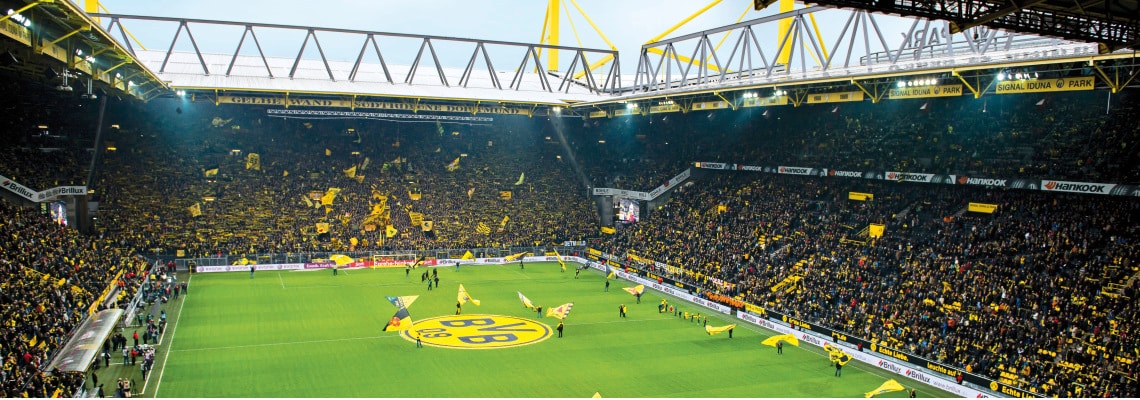
Smart pumps for Dortmund’s football temple
“An atmosphere that only a true football arena can achieve”. This is how the SIGNAL IDUNA PARK was described on 2 April 1974 on its christening with a friendly match against FC Schalke 04. Since the third expansion stage was completed, the Dortmund stadium is among the largest stadiums in Europe. For its smooth operation, the sports venue in the Ruhr area relies on the smart pump technology provided by the Wilo-Stratos MAXO.
At 62 metres high, the eight yellow floodlight towers on the SIGNAL IDUNA PARK are a distinctive feature of the Dortmund skyline. With space for 81,365 fans, Dortmund’s stadium is the biggest in Germany - the legendary south stand, known as the “Yellow Wall”, is Europe’s largest standing-only terrace.
If you had told the people of Dortmund fans over fifty years ago about a venue on this scale with a glass facade and undersoil heating you probably would have caused nothing but a disbelieving head shaking. Today, the modern stadium on Strobelallee has long since become a reality. Borussia Dortmund and the venue also recognise their environmental responsibility: “In times of increasingly scarce resources and increasing environmental pollution, it is of course essential for us to take up and deal with ecological consequences as well”, states Carsten Cramer, BVB-CEO. “We consider responsible energy use and the associated reduction of harmful emissions to be our fundamental and essential economic goals. This includes increasing energy efficiency.”
The challenge: reliability and performance cannot be allowed to suffer under the efficiency guidelines. In terms of water supply and disposal in general, football stadiums have a very heterogeneous performance profile. During the game water use drops significantly, however, it increases dramatically at half-time, not least because of the heavy use of sanitary facilities at this point.
For many years the home of Borussia Dortmund has counted on the energy efficient, reliable and high-performance products of Dortmund technology company Wilo. From the water supply for the VIP areas, to the changing room heating and the undersoil heating system: Wilo product solutions create a green environment.
Since 2019, new Wilo-Stratos MAXO models have been providing the supply for the south stand.
The “La Scala of German football”
The history of the stadium begins in the mid 1960s when the decision was made to build a second stadium alongside the outdated “Rote Erde” arena in time for the 1974 football World Cup. Just in time for the 76th Ruhr derby in 1974, everything was ready: the stadium, then known as the Westfalenstadion, opened its doors to 54,000 standing spectators for the friendly match featuring home team Borussia Dortmund against FC Schalke 04. Until the start of the 1990s the Dortmund venue remained largely in its original condition. A total of three expansion stages have turned the SIGNAL IDUNA PARK into the “La Scala of German football” - through the proximity to the pitch, the acoustics and the unique enthusiasm of the black and yellow football fans.
Even the home of football acknowledges its character: the well-known English newspaper The Times named the SIGNAL IDUNA PARK as the world’s best stadium thanks to its atmosphere and facilities.
Wilo-Stratos MAXO – the world’s first smart-pump*
“Pioneering for You” – the driver behind everything we do. The newest example is our Wilo-Stratos MAXO smart-pump. It defines a new category of pump: outstanding ease of use and simple to connect. Its unique characteristic is the large and easy-to-read colour display, which comes as standard for all series. Combined with Green Button Technology, it offers intuitive operation thanks to application-guided settings with the Setup Guide.
Product informationSmart technology - comprehensive communication
The new Wilo-Stratos MAXO for HVAC and drinking water applications in large buildings sets new standards in energy efficiency - extensive studies and customer interviews enabled Wilo to design a pump which is completely tailored to the customer’s needs, even from the earliest development stage.
“Our Stratos MAXO is the first smart-pump in the world . Thanks to fully optimised and innovative energy-saving functions like Multi-Flow Adaptation and No-Flow Stop, in addition to a very good EEI of ≤ 0.19 to ≤ 0.17 depending on the model, it also sets new standards for system efficiency in the market”, says Michael Dieckmann, product manager at Wilo.
With its high connectivity, the Wilo-Stratos MAXO can be more flexibly integrated into a wide variety of applications. From integration in building automation to control via app, Wilo uses intelligent and smart technologies to ensure a comprehensive communication capability – naturally, this also applies to the Wilo-Stratos MAXO.
With the help of the most recent version of the Wilo-Assistant app, Wilo delivers the entire world of high-efficiency pump technology directly to smartphones and tablets. The new design and the intuitive user guidance are even more useful for tradespeople, consultants and operators in their daily work. New functions and connective solutions add to the range of features already offered by the previous Wilo-Assistant. Sites and central operating statuses can be called up and monitored in real time. But the app, with its remote control and remote maintenance functions, also provides advance support, e.g. during planning and pump selection, during installation and commissioning and during operation.

